
Anigrand 1/72 XP-62
| KIT #: | AA-2076 |
| PRICE: | $54.00 MSRP |
| DECALS: | One Option |
| REVIEWER: | John Doerr |
| NOTES: | Resin kit |

| HISTORY |
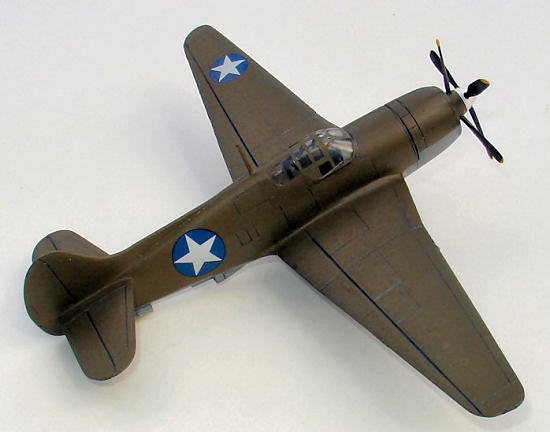 Anigrand
has built a tradition of releasing unique models that main stream companies do
not cover. I can’t imagine, given
their esoteric subject matter of experimental and prototype aircraft that the
major companies would ever sell enough to recover their investment.
The release of these aircraft does fill a niche that somewhere, at least
one or more of their kits would appeal to most modelers, to complete their
particular collection. Also to
their credit Anigrand has a reputation of high quality, well fitting casting
Anigrand
has built a tradition of releasing unique models that main stream companies do
not cover. I can’t imagine, given
their esoteric subject matter of experimental and prototype aircraft that the
major companies would ever sell enough to recover their investment.
The release of these aircraft does fill a niche that somewhere, at least
one or more of their kits would appeal to most modelers, to complete their
particular collection. Also to
their credit Anigrand has a reputation of high quality, well fitting casting
Background
The Curtiss Airplane Company was in deep trouble. They had been the leading fighter producer with the P-36 and P-40s but it seems they suffered from a hardening of the corporate arteries. As much as they tried to update their P-40 line or advance new designs, it seems that their designs just never seemed to be good enough to warrant both the investing money into the programs and upsetting the wartime production quotas. XP-62 was built to fulfill the high altitude interceptor mission. Only one was built and quietly scrapped before even completing the test program. The XP-62 was the last Curtiss designed prop fighter.
| THE KIT |
The Anigrand XP-62 kit consists of 30 pieces, nine of which are the engine and prop. The moldings are done in a tan resin with crisp petite recessed line lines. The parts come loose with very little flash and no pour reservoirs, just a few stubs. Clean up of the parts is quite minimal and easy. See the preview for info on the kit itself
Dry fitting the fuselage halves together revealed an outstanding match up. The resin canopy was just slightly cloudy but no worse than most plastic kits. A dip in Future and it became crystal clear.
| CONSTRUCTION |
 Construction
of this kit simple and easy, providing care and time was taken to allow the
CA to harden and cure properly.
The fit of all the pieces was very good overall.
There were a few gaps to be filled.
All of the pieces required minor clean up of flash and tabs, with a
small number of bubbles to be filled.
The bubbles were filled with gap filling CA.
The filed areas were sanded smooth, then a light coat of Mr. Surfacer
was applied and the areas polished.
I did not want to be dealing with filling and sanding the more fragile
areas after the initial construction
Construction
of this kit simple and easy, providing care and time was taken to allow the
CA to harden and cure properly.
The fit of all the pieces was very good overall.
There were a few gaps to be filled.
All of the pieces required minor clean up of flash and tabs, with a
small number of bubbles to be filled.
The bubbles were filled with gap filling CA.
The filed areas were sanded smooth, then a light coat of Mr. Surfacer
was applied and the areas polished.
I did not want to be dealing with filling and sanding the more fragile
areas after the initial construction
Oddly enough construction did not start with the cockpit.
Being an OOB build for the Nostalgic Plastic display at the upcoming
Nationals, meant no extra detail would be added to the cockpit, which consisted
of molded in blank sidewalls and consoles, and a generic looking stick and seat.
If I was building this for my own display I would add a better looking
seat and stick and add at
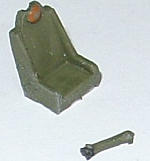 least
decals to busy up the consoles and instrument panel.
The entire inner cockpit surfaces can be easily reached and painted
after assembly.
least
decals to busy up the consoles and instrument panel.
The entire inner cockpit surfaces can be easily reached and painted
after assembly.
Initially I primered and painted the interior. However I then realized I would need to sand much of it and let it go. I started by gluing the fuselage halves together and filling any gaps that existed. The seams were then sanded down with progressively finer grit until smoothed and any lost panel lines were rescribed. The tail empennage was added next and the same procedure followed like wise after I added the stabilizers and wings. The wings, fin and stabilizers all have locating pegs that mate to holes in the fuselage. The fit was not perfect but using slow hardening CA allowed me to line everything up properly. There were only a few easily filled gaps, nothing at all like the horror stories I had heard about resin kits
Then I repainted the cockpit Curtiss green, based on Model
Master (MM) enamel interior green but with an added touch of olive drab and bro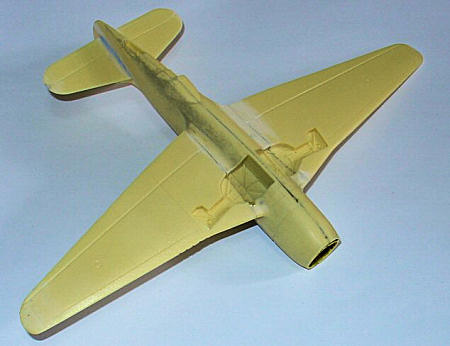 wn,
and the instrument panel and consoles black and added the seat and stick.
The portion behind the seat, visible through the scallops was painted
olive drab.
It was both a Curtiss practice and appeared that way in the few existing photos.
The canopy was added and faired in, then masked off.
I nice touch was the back of the canopy extended well behind the
scallops and made the sanding a relatively easy procedure. During the downtime I
painted and assembled the remaining subassemblies, the engine landing gear and
counter rotating props.
The gears hubs and engine were painted in MM Metalizer steel.
The engine crankcase was painted with Tamiya Extra dark sea gray and
the tires were painted with MM acrylic Marine US Navy 5D, dark gray, which to my
eye is the prefect “tire” color.
A black wash was added to the landing gear and engine to bring out the
details.
wn,
and the instrument panel and consoles black and added the seat and stick.
The portion behind the seat, visible through the scallops was painted
olive drab.
It was both a Curtiss practice and appeared that way in the few existing photos.
The canopy was added and faired in, then masked off.
I nice touch was the back of the canopy extended well behind the
scallops and made the sanding a relatively easy procedure. During the downtime I
painted and assembled the remaining subassemblies, the engine landing gear and
counter rotating props.
The gears hubs and engine were painted in MM Metalizer steel.
The engine crankcase was painted with Tamiya Extra dark sea gray and
the tires were painted with MM acrylic Marine US Navy 5D, dark gray, which to my
eye is the prefect “tire” color.
A black wash was added to the landing gear and engine to bring out the
details.
All went well until I tried adding the canopy.
The canopy was a clear resin gem.
It was nice and clear with well defined frames.
However, when I attempted to add the canopy it was wide at the back
end plus it fell short in both the vertical, and length.
I aligned the front portion, and because the area it mated to on the
aft side was windowless I decided to make my adjustments th ere.
It took four days of intermittent sanding and filling with both putty
and gap-filling CA, not to mention coats of Mr. Surfacer to get it filled.
There still remains a slight, smoother rise through the transition
zone, especially on the right side that is visible from certain directions.
ere.
It took four days of intermittent sanding and filling with both putty
and gap-filling CA, not to mention coats of Mr. Surfacer to get it filled.
There still remains a slight, smoother rise through the transition
zone, especially on the right side that is visible from certain directions.
The landing gear also presented problems. The legs and support struts are in one piece and the wheels nicely done. The alignment is off giving the wheels a toe in on the forward side. The doors are very thick and out of scale in thickness. The three-piece doors are in one piece to be cut a part. The cut lines between the outer door and strut cover is fine, but the cut scribing between the inner, wheel door, and the strut cover is is miss marked. I initially made my cut on the scribed lines and discovered too late. On the left gear door the cut is made at angle so bottom of the strut door is parallel to the ground in a three-point stance. The right door is scribed opposite. After checking my photos, the bottom of the strut door should be perpendicular to the strut. The offending portions were cut from the wheel door, then added to the strut door, filled, sanded and smoothed.
| COLORS & MARKINGS |
Here is where I ran into the biggest problem of the kit. The lack of documentation. Very few photos exist and they are all exterior views showing the prototype wearing an olive drab and neutral gray scheme. I decided due to the lack of definite information the cockpit would be in Curtiss green, with all other interior surfaces in zinc chromate primer. The Curtiss green was mixed, as stated previously and Tamiya yellow green was used for the zinc chromate. MM enamel olive drab and neutral gray were used to complete the painting
| CONCLUSIONS |
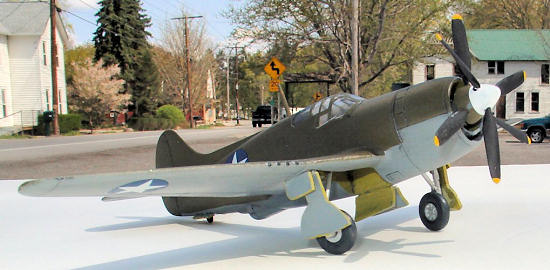
| REFERENCES |
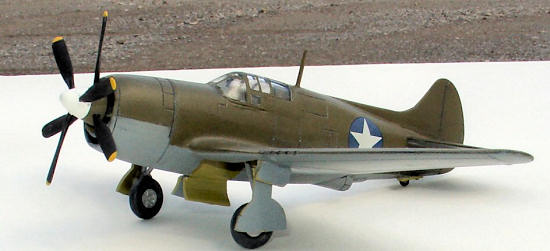 http://en.wikipedia.org/wiki/Curtiss_XP-62
http://en.wikipedia.org/wiki/Curtiss_XP-62
May 2008
Copyright ModelingMadness.com. All rights reserved. No reproduction in part or in whole without express permission from the editor.
If you would like your product reviewed fairly and quickly, please contact the editor or see other details in the Note to Contributors.